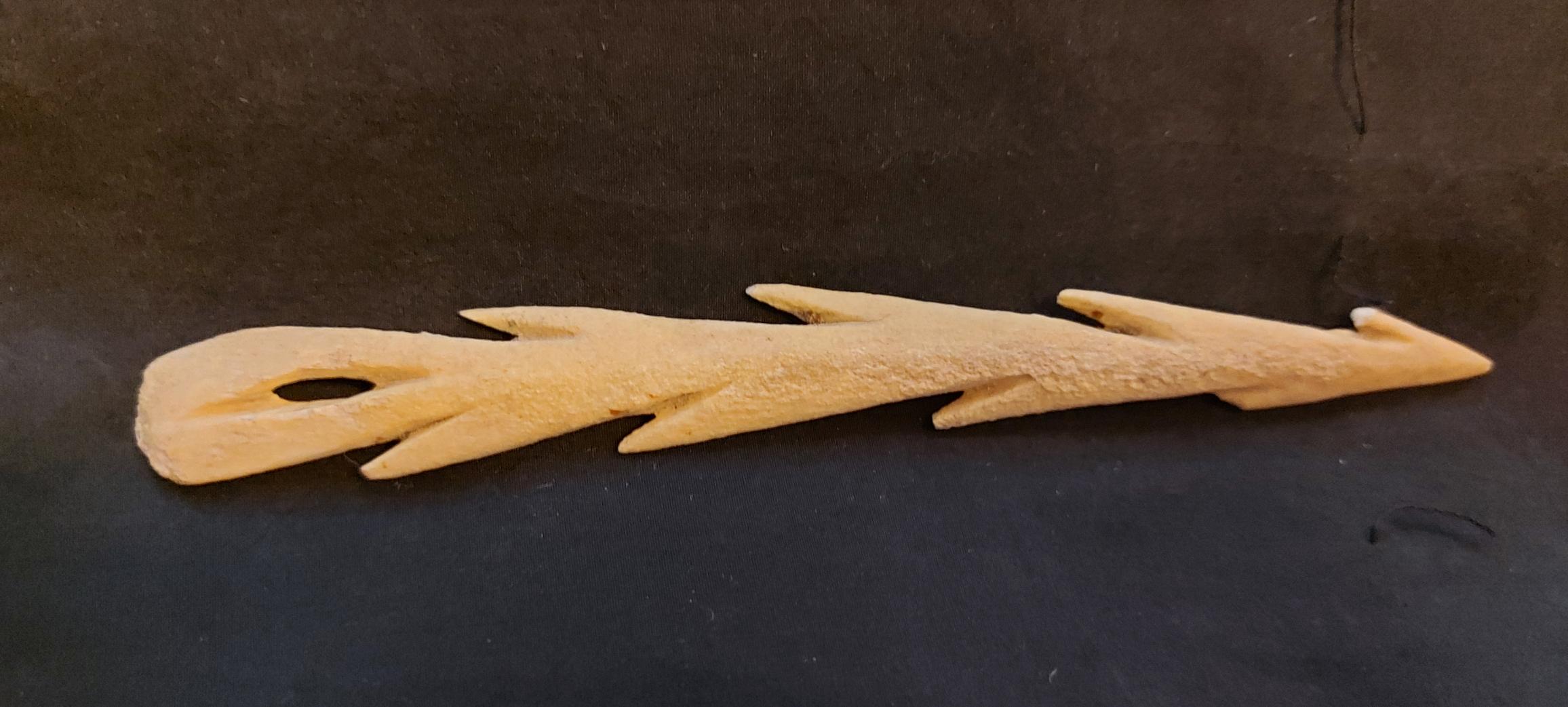Blog
Most of our nostalgic school trip souvenirs are pressed pennies or pantomime tickets. Maybe a photo in an album? However, 12-year-old Fiona Bowie’s memento turned out to be a nationally-important treasure. On her school trip to the Arisaig beach 50 years ago, she found what turned out to be a Mesolithic harpoon head. And after half a century of memories, Fiona has been kind enough to hand this fascinating tool into the museum, where we now proudly have it on display. It has been reported to the Treasure Trove Unit, in accordance with Scots law, for eventual allocation by the Queen’s and Lord Treasurer’s Remembrancer.
As an archaeology student, I am always intrigued by little objects with big stories that give us a glimpse into our mysterious ancestors' lives. And this artefact does just that. I knew that harpoons in good condition, especially to this degree, were extremely rare in Scotland, and therefore this window into the way of life of Mesolithic people is precious. However, beyond this and the original function of the harpoon for hunting, I wasn't knowledgeable enough to decode its story. As part of my research into this intricate artefact, I was incredibly lucky to be able to talk to Dr Alison Sheridan, a revered archaeologist, about the harpoon. Alison is the recently retired Principal Archaeological Research Curator at National Museums Scotland and 2020’s Current Archaeologist of the Year, among many other impressive career highlights.
Alison explained the harpoon reveals that it is likely Mesolithic hunter-fisher-foragers walked the shores of Arisaig beach, as the design lends itself to being a tool for hunting sea mammals. When I enquired about the design and how the harpoon was adapted for Mesolithic life, Alison explained that it was a biserially barbed harpoon (this means that there are barbs on each side). There is also an oval-shaped hole near the end of the harpoon, with a straight hollow extending to the end of the harpoon. This provides a place for a thong to go. This shows how the Mesolithic people had an eye for intricate and practical design. The barbs would ensure that the harpoon lodged in the prey when it was thrown or thrusted, and the thong would have enabled the hunter to drag the prey back by preventing it from swimming away, and would prevent the harpoon head from getting lost during a hunt.
There is also much this harpoon can show us about prehistoric times. Alison outlined valuable further research that should be done on this object, due to its rarity. A specialist could help us identify the species and material the harpoon is carved from (most likely bone, although antler is also possible), giving us insight into the workings of the Mesolithic community. Microwear analysis on the hole, tip and barbs could reveal whether the harpoon had been used. Investigation into the type of tools used to create the harpoon could be conducted through a variety of methods, including microscopic analysis. This would all give more context to the harpoon and the people who used this little tool. Radiocarbon dating the piece would also be useful, to get a more precise date for it. However, a sample must be taken for this process which would spoil the harpoon’s pristine appearance, and if the object was made of whalebone, radiocarbon dating wouldn't be reliable in any case, so the first task is to identify the raw material, before considering undertaking any destructive analysis. The piece is believed to date to around 5000 BC due to the design and by inference from other radiocarbon-dated harpoon heads found in Scotland.

During Mesolithic times, Scotland was a very different world. Mesolithic people lived in camps, moving around seasonally as food resources came into abundance, and they lived solely on what nature provided. While elsewhere in Scotland the sea level would have been very different from nowadays in 5000 BC, as it happens, in this part of Scotland it would have been similar to today’s sea level. It is likely they would have camped out by the shore where the harpoon was discovered to fish and hunt for seals, given that the area would have had an abundance of sea life. Alison also suggested that we look into publishing details of the artefact in the Archaeology Scotland magazine, to put our harpoon into its deserved spotlight, both with the archaeological community and the public as a whole. We shall be doing that over the next few weeks. A 3D print of the model is also something we could consider, as a replica could then be used as teaching models for local schools. We could also use replicas in fundraising for the museum.
The harpoon has already been shown to be highly important, revealing a fascinating glimpse of our local area 7000 years ago. We have only scratched the surface; there is much more to be discovered about it. The harpoon is in almost perfect condition, so you can imagine it in our prehistoric ancestors' hands. Come along to Fort William and experience this extremely rare find for yourself.
Georgie Burns
Archaeology Undergraduate
University of Highlands & Islands
and West Highland Museum volunteer











